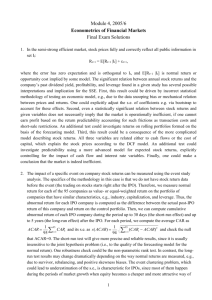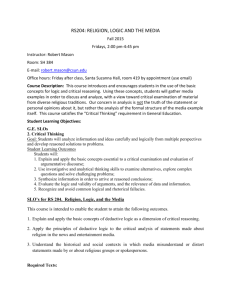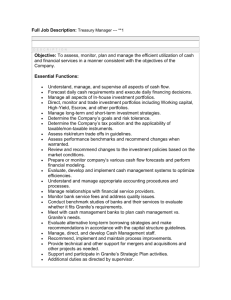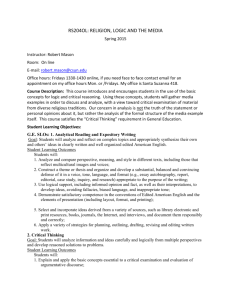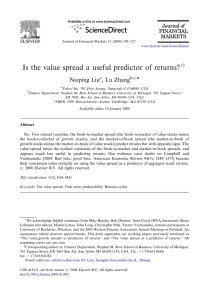The Size and Book-to-Market Effects and the Fama
advertisement
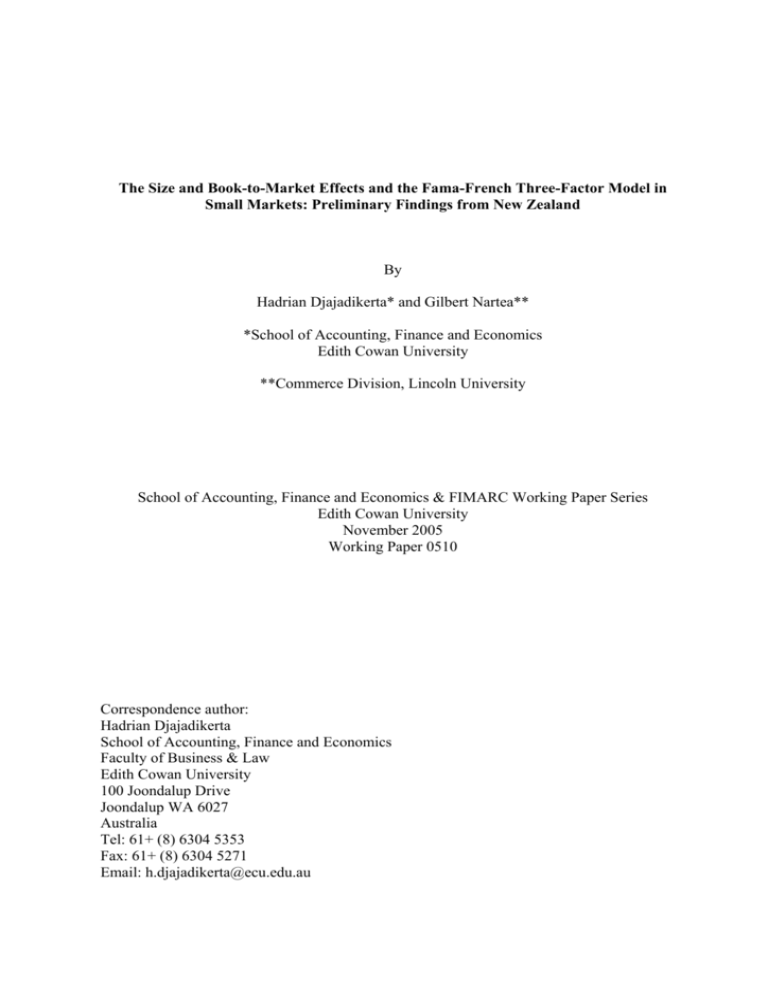
The Size and Book-to-Market Effects and the Fama-French Three-Factor Model in Small Markets: Preliminary Findings from New Zealand By Hadrian Djajadikerta* and Gilbert Nartea** *School of Accounting, Finance and Economics Edith Cowan University **Commerce Division, Lincoln University School of Accounting, Finance and Economics & FIMARC Working Paper Series Edith Cowan University November 2005 Working Paper 0510 Correspondence author: Hadrian Djajadikerta School of Accounting, Finance and Economics Faculty of Business & Law Edith Cowan University 100 Joondalup Drive Joondalup WA 6027 Australia Tel: 61+ (8) 6304 5353 Fax: 61+ (8) 6304 5271 Email: h.djajadikerta@ecu.edu.au Abstract This study uses New Zealand stock market data from 1994-2002 to investigate size and book-to-market as determinants of returns in New Zealand share market, and the ability of the Fama-French three-factor model to explain the variation in stock returns. The results suggest a statistically significant size effect but a weak book-to-market effect. Additionally, the study also finds some improvement in explanatory power provided by the three-factor model relative to the conventional Capital Asset Pricing Model although not in the same magnitude as those reported in studies using relatively larger markets. 1. Introduction The Capital Asset Pricing Model (CAPM) postulates that the variation in stock returns is solely determined by the market beta. However, several empirical studies show that the CAPM market beta has very little relation to stock returns (Reinganum, 1981, Breeden, Gibbons and Litzenberger, 1989, Fama and French, 1992). On the other hand, several studies document relationships between returns and variables such as size (market capitalisation), and book-to-market ratio. The size effect was first documented by Banz (1981) and Reinganum (1981) who found a return premium on small stocks in the United States (US). The size effect was later confirmed by Blume and Stambaugh (1983) using US data and by Brown, Keim, Kleidon and Marsh (1983) using Australian data. The book-to-market effect was first documented by Rosenberg, Reid and Lanstein (1985) who found a return premium to stocks with high ratios of book-value to market-value of equity. This book-to-market effect is confirmed by Davis (1994) for US data and by Chan, Hamao, and Lakonishok (1991), Capaul, Rowley and Sharpe (1993) and Fama and French (1998) for markets outside the US. Several other scholars have also documented other variables related to stock returns such as earnings-price ratio (Basu, 1983), research and development (Al-Horani, Pope and Stark, 2003), and idiosyncratic volatility (Drew, Naughton and Veeraraghavan, 2004). All of the above studies suggest that a single factor model (CAPM) is not suitable to explain the relationship between risk and return. So far there is no agreed-upon model to replace CAPM. However, the most well known model in the current finance literature is the Fama-French three-factor model (see Fama and French, 1993, 1995, 1998). In their early work, Fama and French (1992) find that size and book-to-market explain most of the variation in US stock returns. In their later study using data from New York Stock Exchange (NYSE), Fama and French (1993) analyse 25 stock portfolios from July 1963 to December 1991 on the basis of size and book-to-market equity and argue that the cross section of average returns on US stocks can be explained by the excess market return, a size factor, and a book-to-market equity factor. The three-factor model explains the size and book-to-market effects as compensation for holding less profitable, riskier stocks, ie as risk premia. Opponents of this view adopt a behavioural explanation and suggest that the book-to-market effect is not a result of 2 compensation for risk bearing but due to investors extrapolating past performance too far into the future which leads to the underpricing of high book-to-market firms (value stocks) and overpricing of low book-to-market firms (growth stocks) (DeBondt and Thaler, 1987, Lakonishok, Shleifer and Vishny, 1994, and Haugen, 1995). The behavioural explanation of the book-to-market effect is a variant of the characteristic explanation proposed by Daniel and Titman (1997), who argue that the book-to-market effect is a manifestation of investor preference for certain characteristics of firms, in this case a preference for growth stocks and a dislike for value stocks. Daniel and Titman (1997) use data from NYSE and form 25 stock portfolios on the basis of size and book-to-market equity for July 1963 to December 1993, similar to those used by Fama and French (1993), and reject the Fama-French three-factor model. They find that size and book-to-market ratios are both highly correlated with the average returns of common stocks, but in contrast to Fama-French’s argument, Daniel and Titman conclude that more likely the characteristics, rather than the covariance structure of returns, explain the cross-sectional variation of returns. In response, Davis, Fama, and French (2000) using an extended data set from 1929 to 1997 contend that Daniel and Titman’s (1997) results are specific only to the relatively short data set that they used and consequently came out in favour of the risk explanation. The Fama-French three-factor model was developed mainly on US data, and hence the findings may arguably be relevant only in a US setting. Fama and French (1998) confirm their three-factor model using data from several international markets. However, their data set was dominated by a small number of large firms. Griffin (2002) on the other hand, using monthly data for 1521 companies in Japan, 1234 in the United Kingdom, and 631 in Canada from January 1981 to December 1995, suggests that practical applications of the Fama-French three-factor model are best performed on a country-specific basis. In the Asia Pacific region, very little evidence has been published on the Fama-French three-factor model and the results of these publications have been inconclusive at best. For instance, Daniel, Titman and Wei (2001) continue the Daniel and Titman’s (1997) study by examining monthly data on common stocks listed on the Tokyo Stock Exchange (TSE) from January 1971 to December 1997. They reject the Fama-French three-factor model in favour of the characteristic model. On the other hand, Lam (2002) using data for 100 firms listed in the 3 Stock Exchange of Hong Kong (SEHK) from July 1980 to June 1997 reports results that seem to support the three-factor model. Lam (2002) finds that beta is unable to explain the average monthly returns on stocks, but size, book-to-market equity, and earnings-price ratios seem able to capture the cross-sectional variation of returns. Australian studies generally find support for the three-factor model to varying degree. Among the few notable papers from Australia are those by Halliwell, Heaney and Sawicki (1999), Faff (2001) and Gaunt (2004). In their study using data from the Australian Stock Exchange, which spans a period from January 1981 to June 1991, Halliwell, Heaney and Sawicki (1999) conclude that the parameter magnitudes and statistical significance of their findings are in general comparable with Fama and French (1993). They report a statistically significant size effect but find little evidence of a statistically significant book-to-market effect and conclude that the role of this factor may not be as strong as suggested in the literature. Faff (2001) uses 24 Australian industry portfolio data from Datastream International covering a period from January 1991 to April 1999, and finds strong support for the Fama-French three-factor model. However, he also states that the conclusion favouring the model has to be downweighted somewhat by the fact that though he reports a statistically significant size beta, it is of the ‘wrong’ sign. Faff explains this negative size premium as being consistent with recent findings of a reversal of the size effect with large firms earning a risk premium (Gustafson and Miller, 1999). Finally, Gaunt (2004) extends the Halliwell, et al. (1999) data set and covers a period from 1993 to 2001. Gaunt (2004) reports a statistically significant size effect, consistent with Halliwell, et al. (1999). However, contrary to Halliwell et al. (1999), Gaunt (2004) finds some evidence of a book-to-market effect and a significant improvement in the explanatory power of the three-factor model over the conventional CAPM. So far there have only been a few published New Zealand studies on this topic. Two imperative studies are those by Bryant and Eleswaparu (1997) and Vos and Pepper (1997). Bryant and Eleswaparu (1997) present a significant positive relationship between book-tomarket ratios and average return over the period of 1971 to 1993 on the New Zealand share 4 market, but they do not find a strong role for firm size in security returns. Vos and Pepper (1997) use a smaller sample size over the period of 1991 to 1995 and conclude similarly a positive relationship between book-to-market and returns. However, contrary to Bryant and Eleswaparu’s findings, Vos and Pepper find that size is a strong explanatory variable of returns in New Zealand share market. The purpose of this paper is to assess the conclusion of these previous New Zealand studies by conducting a similar study using more recent data. Hence, the results of this study can update and enhance our knowledge of the practical applicability of the Fama-French three-factor model in a small economy like New Zealand. Consequently, the study aims to contribute to the findings from non-US research. In this study, New Zealand stock data from 1994 to 2002 are used. Nine portfolios composed of stocks classified according to size and book-to-market (BM) ratios are formed (e.g. small size/low BM; medium size/low BM; small size/medium BM, etc.). Subsequently, both the one-factor (CAPM) and the three-factor (Fama-French) model are estimated for each of the portfolios. Results of these estimations are used to verify the existence of size and book-to-market effects. Analysis of the three-factor model estimates is also used to indicate whether or not the size and book-to-market risk factors contribute significantly to explaining realised returns. Our results are not consistent with the two previous New Zealand studies (Bryant and Eleswaparu, 1997, and Vos and Pepper, 1997). We find a statistically significant size effect but a weak book-to-market effect. Additionally, we also find some improvement in explanatory power provided by the three-factor model relative to the conventional CAPM although not in the same magnitude as those reported in the Australian study (Gaunt, 2004) and the US study (Fama and French, 1993). Section 2 of the paper describes the methods and reports summary statistics for the nine stock portfolios. Section 3 presents regression results comparing the conventional one-factor CAPM with the three-factor model and section 4 concludes the paper. 5 2. Methodology and data At the end of each calendar year from 1993 to 2001, companies are selected to be included in the study. To be included, the company must have a price record at the end of the year and publicly available accounting data as of June of the same year. The selected companies are then ranked by size (market capitalisation as of December) and sorted into three groups with an equal number of companies in each group. Group 1 comprises the smallest companies while group 3 comprises the biggest. The companies are also independently ranked by bookto-market ratio. Book-to-market is shareholder equity divided by market capitalisation both as of June of that year. Shareholder equity is defined as total reported shareholder equity minus the value of preferred shares and outside equity interests. According to the book-to-market ranking, group 1 is made up of companies with the lowest book-to-market (growth or glamour stocks) while group 3 is made up of companies with the highest book-to-market (value stocks). Nine portfolios are formed at the end of each year using companies at the intersection of the size and book-to-market groups. For example, portfolio 1 consists of stocks belonging to both size group 1 and book-to-market group 1 (ie, small companies with low BM), portfolio 2 consists of stocks belonging size group 1 and book-to-market group 2 (ie, small companies with medium book-to-market), and so on. Value weighted returns are computed for each of the nine portfolios that are formed at the end of each year. This is done over a 12 month period after the portfolio formation date. For example, portfolios formed as of December 1993 will be tracked in 1994. This produces a series of monthly returns over the period 1994 to 2002 for each of the nine size/book-tomarket portfolios. No integrated accounting and stock market data exists for New Zealand companies so these data are obtained from various sources. Company accounting data is obtained from the Investment Research Group Ltd (IRG), dividend data is obtained from Datastream International, and stock market data is obtained from the New Zealand Exchange (NZX). 6 Table 1 summarises the characteristics of the nine portfolios. Panel A shows that the average annual number of companies in each portfolio ranged from 4 to 9.4 with the highest number of companies falling in the small-high book-to-market and big-low book-to-market categories. The big-high book-to-market category has the lowest average number of firms. Panel B shows that the average market capitalisation of the companies making up the portfolios ranged from $13.5 million for the small-high book-to-market, to $1,947 million for the big-low book-to-market. It can be seen from Panel B that within the medium and big size categories, size (market capitalisation) tends to be negatively related to book-to-market. In this case, care must be taken in interpreting book-to-market effects for these size categories as the size effect could amplify the observed book-to-market effect. Panel C shows book values ranging from $7 million to $1,044 million. Panel D shows average book-to-market ratio ranging from 0.31 to 1.80. Within the high book-to-market category, there is a tendency for book-to-market to fall as firm size increases. [Insert Table 1 about here.] Table 2 shows the raw returns and the risk premium for each of the nine portfolios. Size and book-to-market effects are evident from Table 2 but these results are mixed. Panel A shows a tendency for small and medium size portfolio returns to increase with book-tomarket. However contrary to expectations the reverse is true for big firms in our sample, where returns are negatively related with book-to-market. Panel B also shows a size effect with raw returns decreasing with size in accordance with expectations, but this is evident only for high book-to-market portfolios. For low book-to-market portfolios in our sample, contrary to expectations raw returns are positively related to size. Both the CAPM (equation 1) and the Fama-French three factor model (equation 2) are estimated: RP(t) – RF(t) = a + b[RM(t) – RF(t)] + e(t) (1) RP(t) – RF(t) = a + b[RM(t) – RF(t)] + sSMB(t) + hHML(t) + e(t) (2) 7 RP(t) is the portfolio return at time t, RF is the risk-free rate which is the one-month Treasury bill rate, RM is the market return calculated from the NZSX ALL Gross Index which comprises all domestic equity securities listed on the New Zealand Exchange. SMB is the difference between the returns on small minus big size firms (ie., a mimicking portfolio of long small capitalisation stocks and short big capitalisation stocks). HML is the difference between the returns on high book-to-market firms and low book-to-market firms (ie., mimicking a portfolio of long value stocks and short growth stocks). To calculate SMB and HML, companies are first ranked independently by size and book-to-market. At the end of each year, the companies are ranked into two size groups, small (S) and big (B), of equal number of companies. The companies are then also independently ranked into two book-tomarket groups, low book-to-market (L) and high book-to-market (H), of equal number of companies. The intersections of the size and book-to-market groups form four portfolios, S/L, S/H, B/L, B/H. S/L is the portfolio made up of small firms with low book-to-market, S/H is a portfolio of small firms with high book-to-market, and so on. SMB is the difference between the simple average return of the two small size portfolios (S/L, S/H) and the two big size portfolios (B/L, B/H). HML is the difference between the simple average return of the two high book-to-market portfolios (S/H, B/H) and the two low book-to-market portfolios (S/L and B/L). SMB should be free of book-to-market effects on returns while HML should be free of size effects. Indeed, the correlation between SMB and HML for January 1994 to December 2002 is only -0.12 which indicates that SMB and HML are relatively free of the book-tomarket and size effects, respectively. [Insert Table 2 about here.] 3. Results Table 3 shows the regression results for the conventional CAPM (equation 1). The results are consistent with expectations. The intercept terms are not statistically significant, while the beta coefficients are significant though they can explain only 17-58% of the total variation in returns as evidenced by the adjusted R2. The beta of the nine portfolios are all statistically significant ranging from 0.68 to 1.13. Most portfolios have a negative intercept or abnormal return, though, as expected they are not statistically significant. The intercepts 8 exhibit a size effect that mirrors the earlier observation with raw returns in Table 2. Abnormal returns increase as size falls for high book-to-market portfolios consistent with expectations. But this tendency is reversed for low book-to-market portfolios contrary to expectations. The book-to-market effect likewise mirrors those observed with raw returns in Table 2. Consistent with expectations, increasing abnormal returns are observed from low to high book-to-market portfolios. But this is true only for the small and medium size portfolios. For big portfolios abnormal returns decrease from low to high book-to-market portfolios, contrary to expectations. [Insert Table 3 about here.] Table 4 shows the regression results for the three-factor model (equation 2). The intercept terms are almost the same as those estimated for the conventional one-factor CAPM suggesting that the latter explains almost the same amount of variation as the three-factor model. This is confirmed by comparing the adjusted R2 of the two models. The three-factor CAPM shows only a slight increase in the adjusted R2 compared with the conventional CAPM. In our sample only three out of nine portfolios registered an increase in their adjusted R2 of more than 10 percentage points. The adjusted R2 in our sample ranged from 29% to 74%. The tendencies for the intercept to increase/decrease with size for the low/high book-tomarket portfolios observed in the one-factor CAPM are still evident. The intercepts ranged from -1.65% to 0.27%, but as expected are generally not statistically significant. The betas, on the other hand, are all statistically significant ranging in value from 0.71 to 1.16. The tendency of beta to increase with size observed in the one-factor CAPM is still evident for the medium and high book-to-market portfolios but this tendency is reversed for the low book-tomarket portfolios. The magnitude of the beta estimate compared with its counterpart s and h estimates suggest that it is the dominant explanatory variable in the three-factor model. There is evidence that SMB possesses explanatory power with all but two of the SMB coefficient estimates being statistically significant. We observe a monotonic increase in the 9 risk factor loading on SMB from big to small portfolios. The sign of the SMB coefficient estimate for the big size portfolios are negative though only the big-low book-to-market portfolio is significant. There is also some evidence of HML having explanatory power, with five out of nine portfolios having a statistically significant estimate of the HML coefficient. There is also evidence of an increase in the HML factor loading from low to high book-to-market portfolios. We also find a negative HML coefficient for the low book-to-market portfolios though only the coefficient of the big-low book-to-market portfolio is statistically significant. [Insert Table 4 about here.] 4. Concluding remarks This study has set out to add to the evidence verifying the size and book-to-market effects and the three-factor model in a small economy and a small stock market. Our results confirm the presence of a relatively significant size effect and a weak book-to-market effect. These results, however, are not consistent with the previous New Zealand findings. Bryant and Eleswaparu (1997), using New Zealand share market data over the period of 1971 to 1993, present a significant book-to-market effect and a weak size effect. Vos and Pepper (1997), using a smaller New Zealand sample size over the period of 1991 to 1995, conclude that both size and book-to-market have significant effects to stock returns. This inconclusiveness in the results may due to the fact that only small number of companies listed on the New Zealand share market, and the high volatility of returns in the period-by-period basis. A small sample size means that it is difficult to form portfolios that are well diversified, and this consequently may influence the robustness of the results. Although beta cannot explain all of the variation in portfolio returns, it is still the dominant explanatory factor in our three-factor model. Nonetheless, SML has explanatory power and there is evidence of a monotonic increase in SML factor loading from big to small portfolios consistent with the US (Fama and French, 1993) and Australian evidence (Gaunt, 2004). While HML also possesses some explanatory power the improvement provided by the 10 three-factor model over the conventional CAPM is due mainly to the addition of the size factor contrary to US evidence but consistent with Australian evidence. In conclusion, the three-factor model provides some improvement over the conventional one-factor CAPM in explaining the returns observed in the New Zealand stock market though the improvement is not as significant as those reported in Fama and French (1993) and Gaunt (2004). The three-factor model still leaves a large part of the variation in New Zealand stock market returns unexplained. Future studies are certainly needed to find a suitable approach that can be used to obtain more conclusive results of the size and book-to-market effects and the three-factor model in small markets. 11 Table 1: Characteristics of Nine Portfolios formed on Size and Book-to-market Equity: 1994-2002. Panel A: Average Annual Number of Companies in Portfolio Low BM Medium BM High BM Small 5.8 6.0 9.4 Medium 8.7 7.8 6.8 Big 9.3 8.6 4.0 Panel B: Average of Annual Averages of Market Capitalisation ($NZ million) Low BM Medium BM High BM Small 16.7 18.0 13.5 Medium 98.3 91.2 81.3 1,947.4 1,112.8 790.6 Big Panel C: Average of Annual Averages of Book Value ($NZ million) Small Medium Big Low BM Medium BM High BM 7.0 16.4 19.8 37.0 68.1 114.8 339.8 959.8 1043.6 Panel D: Average of Annual Averages of Ratio of Book value to Market capitalisation Low BM Medium BM High BM Small 0.36 0.84 1.80 Medium 0.41 0.84 1.70 Big 0.31 0.81 1.65 BM, book to market. 12 Table 2: Raw Returns and Risk Premia for the Nine Portfolios. Panel A: Raw returns (per month) Low BM Medium BM High BM Small -0.75% 0.09% 0.73% High BM - Low BM 1.49% Medium -0.11% 0.52% 0.57% 0.67% 0.89% 0.11% -0.23% -1.12% -1.65% -0.02% 0.96% Big Small - Big Panel B: Risk premium: RP –RF (per month) Low BM -1.31% Medium BM -0.46% High BM 0.18% Medium 5.07% 4.56% 4.52% Big 0.34% -0.44% -0.79% Small BM, book to market RP, portfolio return RF, risk free-return 13 Table 3: Regression Results from the One-factor CAPM Intercept (a) p value Small Low BM -1.46% Medium BM -0.49% Medium -0.70% -0.06% 0.30% -0.48% Big High BM 0.15% Small Low BM 0.09 Medium BM 0.40 High BM 0.84 -0.01% Medium 0.06 0.87 0.97 -0.83% Big 0.39 0.26 0.26 High BM 0.73 Small Low BM 0.00 Medium BM 0.00 High BM 0.00 beta (b) p value Small Low BM 0.86 Medium BM 0.68 Medium 0.95 0.74 0.69 Medium 0.00 0.00 0.00 Big 0.93 1.13 1.00 Big 0.00 0.00 0.00 Small Low BM 17% Medium BM 20% High BM 16% Medium 55% 41% 35% Big 58% 56% 26% adjusted R2 BM, book to market. The Capital Asset Pricing Model (CAPM), RP(t) – RF(t) = a + b[RM(t) – RF(t)] + e(t) is estimated for each of the nine portfolios. 14 Table 4: Regression Results from the Fama-French Three-factor Model Intercept (a) Small Medium Big Low BM -1.65% -0.70% 0.15% Medium BM -0.44% -0.05% -0.34% p value High BM 0.27% Small 0.07% Medium -0.73% Big Low BM 0.04 0.05 0.59 Medium BM 0.44 0.89 0.35 High BM 0.68 0.85 0.31 Low BM 1.02 0.98 0.89 Medium BM 0.71 0.77 1.16 p value High BM 0.80 Small 0.73 Medium 1.00 Big Low BM 0.00 0.00 0.00 Medium BM 0.00 0.00 0.00 High BM 0.00 0.00 0.00 Low BM 0.73 0.29 -0.18 Medium BM 0.33 0.22 -0.03 p value High BM 0.50 Small 0.27 Medium -0.20 Big Low BM 0.00 0.00 0.00 Medium BM 0.01 0.01 0.67 High BM 0.00 0.00 0.21 Low BM -0.11 -0.07 -0.45 Medium BM 0.07 -0.01 0.49 p value High BM 0.29 Small 0.21 Medium 0.35 Big Low BM 0.55 0.33 0.00 Medium BM 0.55 0.90 0.00 High BM 0.04 0.01 0.02 Low BM 29% 61% 74% Medium BM 23% 44% 69% High BM 24% 43% 30% beta (b) Small Medium Big s Small Medium Big h Small Medium Big adjusted R2 Small Medium Big BM, book to market. The Fama-French three-factor model, RP(t) – RF(t) = a + b[RM(t) – RF(t)] + sSMB(t) + hHML(t) + e(t), is estimated for each of the nine portfolios. 15 References Al-Horani, A., P.F. Pope and A.W. Stark, 2003, Research and development activity and expected returns in the United Kingdom, European Finance Review, 7, 27-46. Banz, R., 1981, The relationship between return and market value of common stocks, Journal of Financial Economics, 9, 3-18. Basu, R.W., 1983, The relationship between earnings yield, market value, and return for NYSE common stocks: a further evidence, Journal of Financial Economics, 12, 129156. Breeden, D.T. M.R. Gibbons and R.H. Litzenberger, 1989, Empirical tests of the consumption-oriented CAPM, Journal of Finance, 44, 231-262. Brown, P., D.B. Keim, A.W. Kleidon and T.A. Marsh, 1983, Stock return seasonalities and the tax-loss selling hypothesis: Analysis of the arguments and Australian evidence, Journal of Financial Economics, 12, 105-28. Bryant, P.S. and V.R. Eleswaparu, 1997, Cross-sectional determinants of New Zealand share market returns, Accounting and Finance, 37, 181-205. Chan, L., Y. Hamao and J. Lakonishok, 1991, Fundamentals and stock returns in Japan, Journal of Finance, 46, 1739-1789. Capaul, C., I Rowley and W. Sharpe, 1993, International value and growth stock returns, Financial Analysts Journal, 49, 27-36. Daniel, K. and S. Titman, 1997, Evidence on the characteristics of cross sectional variation in stock returns, Journal of Finance, 52, 1-33. Daniel, K., S. Titman and J. Wei, 2001, Explaining the cross-section of stock returns in Japan: factors or characteristics, Journal of Finance, 56, 743-767. Davis J. (1994), The cross-section of realised stock returns: The pre-COMPUSTAT evidence, Journal of Finance, 49, 1579-1593. Davis, J., D. Fama and K. French, 2000, Characteristics, covariances and average returns: 1929-97, Journal of Finance, 55, 389-406. DeBondt, W.F.M. and R. Thaler, 1987, Further evidence on investor overreaction and stock market seasonality, Journal of Finance, 42(3), 557-581. Drew, M.E., T. Naughton and M Veeraraghavan, 2004, Is idiosyncratic volatility priced? Evidence from the Shanghai Stock Exchange, International Review of Financial Analysis, 13, 349-366. 16 Faff, R., 2001, An examination of the Fama and French three-factor model using commercially available factors, Australian Journal of Management, 26, 1-17. Fama, E. and K. French, 1992, The cross-section of expected stock returns, Journal of Finance, 33, 3-56. Fama, E. and K. French, 1993, Common risk factors in the returns on stocks and bonds, Journal of Financial Economics, 33, 3-56. Fama, E. and K. French, 1995, Size and book to market factors in earnings and returns, Journal of Finance, 50, 131-135. Fama, E. and K. French, 1998, Value versus growth: the international evidence, Journal of Finance, 53, 1975-1979. Gaunt, C. 2004, Size and book to market effects and the Fama French three factor asset pricing model: evidence from the Australian Stock Market, Accounting and Finance, 44, 27-44. Griffin, J.M., 2002, Are the Fama and French factors global or country specific?, The Review of Financial Studies, 15(3), 783-803. Gustaffson, K. and J. Miller, 1999, Where has the small-stock premium gone? Journal of Investing, 8, 45-53. Halliwell, J., J. Heaney and J. Sawicki, 1999, Size and book to market effects in Australian share markets: a time series analysis, Accounting Research Journal, 12, 122-137. Haugen, R., 1995, The New Finance: The Case against Efficient Markets, Prentice Hall, Englewood Cliffs, N.J. Lakonishok, J., A. Shleifer and R. Vishny, 1994, Contrarian investment, extrapolation, and risk, Journal of Finance, 49, 1541-1578. Lam, K.S.K., 2002, The relationship between size, book-to-market equity ratio, earnings-price ratio, and return for the Hong Kong stock market, Global Finance Journal, 13, 163-179. Lintner, J., 1965, The valuation of risk assets and the selection of risky investments in stock portfolios and capital budgets, Review of Economics and Statistics, 47, 12-37. Reinganum, M., 1981, Missspecification of capital asset pricing: Empirical anomalies based on earnings yields and market values, Journal of Financial Economics, 9, 19-46. Rosenberg, B., K. Reid and R. Lanstein, 1985, Persuasive evidence of market inefficiency, Journal of Portfolio Management, 11, 9-17. Sharpe, W., 1964, Capital asset prices: a theory of market equilibrium under conditions of risk, Journal of Finance, 19, 425-442. 17 Vos, E. and B. Pepper, 1997, The size and book to market effects in New Zealand, New Zealand Investment Analysis, 35-45.
